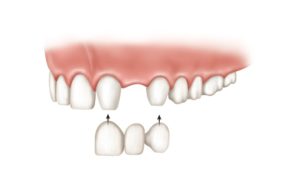Dental Bridges
 Have questions about dental bridges or restorative dentistry? Our dentists took some time to share information and answer common patient questions to help educate about what bridges are and the role that they play in oral health. View the table of contents below to learn more or find your question and get an answer from one of our dentists!
Have questions about dental bridges or restorative dentistry? Our dentists took some time to share information and answer common patient questions to help educate about what bridges are and the role that they play in oral health. View the table of contents below to learn more or find your question and get an answer from one of our dentists!

The following content was provided by Dr. Don Bailey, DDS, and has been medically reviewed for accuracy. Some relevant links have been added to audio transcripts to provide resources for additional information.
Table of Contents:
Click a question below to be taken directly to that answer.
What is a dental bridge?
Answer provided by Dr. Don Bailey. Transcript included below.
Dr. Don Bailey:
A dental bridge is something that a dentist is using to refer to a false tooth that’s fixed in place by crowning the teeth on either side of the missing space. Sometimes people will use a dental bridge to refer to a partial denture, which is different. A partial denture is a false tooth that’s held in on a frame that’s taken in and out of the mouth. A partial denture, a person would wear when they’re awake and take out when they sleep. A dental bridge is fixed in place permanently.
We’ll hear a lot of people use the term interchangeably, but technically speaking, the key thing that makes a dental bridge a bridge is that it’s fixed in place. It’s used to replace one or more of missing teeth without doing implants. And so instead of anchoring the missing tooth into the gum line and the bone ridge, like the original natural tooth was, it’s anchored in place by using the teeth on either side for attachment. In effect, you’re making a series of crowns that are fused together and then cementing them all in at the same time. So if you were missing a front tooth, you would crown the tooth on either side, but then instead of having two individual crowns that are made, there’s three that are fabricated together, and then the entire unit is cemented in at one time, permanently holding the false tooth in place.
What are the types of dental bridges?
Answer provided by Dr. Don Bailey. Transcript included below.
Dr. Don Bailey:
The traditional dental bridge is one that’s capping the entire tooth on either side with a crown. So you’re fully covering the tooth on either side, or teeth on either side, sometimes with a crown that covers the entire tooth. That’s something that’s meant to be a permanent long lasting type of bridge.
There are bridges that are called fixed retainer bridges, which are … a lot of people call the Maryland bridge. But in that one, you’re not tapping the entire tooth on either side with a crown. You may be cementing like a wing onto the back of the teeth on either side, or you may only be capping a very small portion of the tooth. They’re used as a definitive type of bridge, but they’re more temporary in their application in that you’re just bonding it to the back of the tooth. You’re not going to get the same type of hold.
So that would be something that you would more traditionally do on a teen, who’s not ready for their permanent bridge yet, or someone who’s very self conscious about doing a full coverage crown that would cap their entire tooth, they want a more conservative option, you would do the Maryland bridge instead. So if you imagine just the false tooth just having wings on either side that are then shaped into the tooth slightly without covering the entire tooth.
And then the same materials that you would use when you’re making a crown, you could use in making a bridge. You can make bridgework out of gold. You can do it with porcelain layered over gold. You can do it with the lithium disilicate, a hardened glass material. You can do it with the hardened ceramic zirconium dioxide material. So if you think about it, like crowns that are fused together.
Dental bridges vs. Dental implants
Answer provided by Dr. Don Bailey. Transcript included below.
Dr. Don Bailey:
The best way to think about bridges versus implants is … you’re better off thinking of the bridge tooth as a false tooth that’s held in place by using support from either side. But with the implant you’re actually going to put a tooth that’s anchored back in with a root type system, like the original natural tooth had. So instead of having a root there, there’ll be a titanium implant that is embedded into the bone of the ridge just like the original tooth was. So you’re not using teeth on either side for support at all.
The partial plate is removable false tooth. The bridge is a fixed in place permanent false tooth. The implant is basically a synthetic tooth with its own root. That’s the best way to compare them is the traditional bridge or partial is just fitting a tooth back in place and just how you hold it in. With the partial you’re holding it in with a framework or a plate. With the bridge you’re capping teeth. With the implant you’re actually putting teeth back in that site that just happen to be made of ceramic and titanium instead of enamel and root.
So comparing the two, the implant’s a little more involved because you’re having to create a site in the bone and the gum where the original tooth was to receive an implant. Implants look like screws. They look like a bolt, or a wood screw on an x-ray, but they’re not really tapped into the bone like a screw would be into the two by four.
I give the analogy; if you were to take and just screw an implant into the bone, that would be like trying to plant a tree by screwing it into the ground; it would destroy the tree. So you would plant that tree, you would create a bed for it, and then you would place a root ball in, and you would add fertilizer and gravel and soil and water. And over time, the root system of that tree would grow back into the soil and you would have a planted tree. So with the implant, you’re creating a bed for it, and then you’re placing the implant in there, you graft around it. And over time, the bone will incorporate that implant into its own structure.
So the implant’s definitely not a quick fix, versus the bridge, which can be done in just a matter of a couple of weeks. But the advantage of the implant is, is titanium and ceramic do not decay and are very resistant to periodontal disease. So for some people, an implant and the crown over it can be a decade’s long fix, or even a permanent lifelong fix. Where with a bridge, you’re using teeth on either side, you’re shaping them down for crowns, which can eventually wear out. The bridge itself has probably about a 20 year life span at the most.
I think when people are considering it, some people don’t like the idea of shaping the teeth on either side of the missing space to put crowns on there. They would lean more strongly towards an implant. And then there’s some people who don’t like the idea of surgery. They don’t think the cost or the time involved would be what they would want to do, or maybe they have complicating factors like diabetes, peripheral vascular disease, some autoimmune diseases that would affect the bone healing. But generally speaking the implant’s going to be the superior way to go because it’s the most like the original tooth that was lost.
How long do dental bridges last?
Answer provided by Dr. Don Bailey. Transcript included below.
Dr. Don Bailey:
The literature shows that bridges last 10 to 20 years. The actual material of the bridge itself can last a very long time. The reason that bridges can last a shorter amount of time is you’ve connected three teeth together and so they’re a little more difficult to get under and clean then it would be to clean with natural teeth. So sometimes people just aren’t careful to get underneath and clean and they can be more prone to decay underneath the bridge.
So when someone’s coming for regular visits and they’re cleaning underneath, you would hope that a bridge would last about 20 years. Again, even the material holds up that long, but things change like the gum recedes, bone changes shape, so even if someone’s doing the best they can cleaning underneath it, you’ll still have gaps or space open up under a bridge with time. With dental implants, the implant themselves, if they’re placed well, and then they’re not overloaded with too much force, the implants can last for the rest of someone’s life. The crown over them will eventually wear out. So I think we’re considering implant crowns to have more than 20 year lifespan, and the implant itself may be a permanent lifelong fix in some people. But the crown that goes on the implant will eventually wear out as well, but maybe in the 20 to 30 year range.
The titanium implants, they began to be placed in academic settings in higher numbers in the 90s in dental schools. But I would say it was probably the early 2000s before they were really placed in widespread setting in dental practices. And so a lot of the research still is we don’t know how long some of them last. They’re still lasting from their original placement 30 years ago.
What causes dental bridges to fall out?
Answer provided by Dr. Don Bailey. Transcript included below.
Dr. Don Bailey:
Usually if a dental bridge falls out, it’s because decay has entered in under the bridge. So there’s the space between the bridge and the gum where plaque can collect and a toothbrush can’t clean it out. So a person with a bridge would have to be a little extra diligent to get underneath there to clean. There’s flossing aids that the same people that have braces that they use that help them get underneath their bridge, like floss threaders and super floss. They’re just designed to kind of give floss a stiff in, kind of like a shoe lace has, so that you can feed the floss underneath the bridge and then clean by shimmying it back and forth. That’s what you would want to do to clean. For people who can’t, or don’t, sometimes decay will develop underneath the bridge. And once one of those teeth on either end decays enough, the bridge would fall out.
And just eventually over time too, everything changes about our bodies as we age, and that’s still true in our mouth. We have bone loss and gum recession to a degree over time, and for some people they have more than less. So if you have a lot of recession or bone loss, you can have an end of the bridge actually get loose from something like that. I think you’d have to also consider people with heavy clenching habits may be able to damage bridge work, or put so much force on it that it works itself loose.
Why do I need an implant for a dental bridge?
Answer provided by Dr. Don Bailey. Transcript included below.
Dr. Don Bailey:
Most people don’t understand what the implant is. I’ll kind of go into that. The implant is just a platform to support something else. Most of the time that we’re doing implants, we’re attaching a crown to that afterwards. But occasionally orthodontists are using implants to give them an extra anchorage point, and we use implants to support dentures and partial plates and things like that. So the implant itself is just a platform, then we attach something on top of it.
One of the things, over time cost for a lot of things goes down as they become more commonplace and more easy to find. But there are certain things like our cell phones, as the technology keeps changing, they may get more costly over time. I think with implants, the reason that the price hasn’t really dropped on implants in general is because the technology has changed in a way that has made implants more automatic and more predictable, which to me makes them better. What that is is in the past, the implant had to be placed either where the bone dictated it should go or where the aesthetics or function dictated that it should go. So if you had an implant in the bone, would better support an implant at a 45 degree incline, but that would cause the crown to stick out at an odd angle, you would have to compromise and line the implant up in the bone to support the crown at a better angle, which sometimes meant that you were putting the implant in less quality bone or even less thickness of bone.
It used to be pretty standard to expect some amount of bone loss around an implant in the past. But new technology now, which ties into some of the CEREC conversation that we’ve been having with CAD/CAM designing and digital case modeling and things like that, if the implant needs to go in in a 45 degree angle but a tooth has to be lined up at a 20 degree angle, the software can read this and then can mill out a third piece called an abutment, which in the past was just a connector, but now it’s custom milled to correct the angulation issues. So you can now have an abutment that lines the implant and the crown up together without compromising either strength or aesthetics. That’s just expensive technology. So what people are paying for now with implants is just a more sure fit, more sure aesthetics and just a more predictable outcome.

